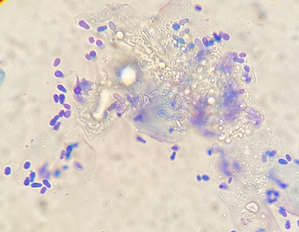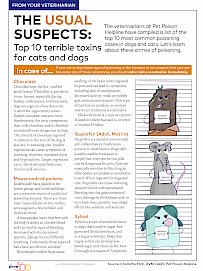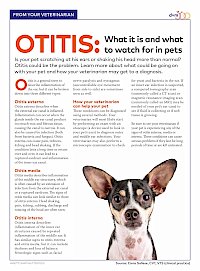Ear Infections and Ear Cleaning
Signs
- Frequent scratching of the ear or shaking of the head
- A foul odor coming from the ear
- Tenderness or irritability when the ear is touched
- Redness or inflammation in the ear
- Black, yellow, or cream-colored discharge from the ear Hematoma: swelling of the ear flap from shaking of the head - caused by broken blood vessels - requires care immediately!
Causes

- Yeast infections - usually a secondary infection
- Bacterial Infections - usually a secondary infection
- Ear mites - tiny spider-like creatures, common in puppies & kittens, contagious!
- Foreign bodies (grass, tick) / Tumors Allergies - cause secondary yeast / bacterial infection
- Trapped moisture - from swimming, excess hair, or conformation (floppy ears) - cause secondary yeast / bacterial infections
Whatever the cause, the earlier the infection is detected, the less pain and discomfort your pet will have to endure and the easier the problem will be to resolve.
Prevention
- Clean ears regularly with a veterinary ear flushing solution - once every 1-2 weeks unless otherwise directed
- Monitor closely for signs and treat early
Treatment
- Home Cleaning / Treatment: To clean ears or administer medication prescribed by your veterinarian at home, squirt it directly into the pet's ear. Make sure the medication runs down into the canal. Massage the ear canal between your finger and thumb. Then allow your pet to shake his head to help loosen debris that lies deeper in the canal. Do not use cotton swabs - they may puncture your pet's eardrum. To clean, use small pieces of cotton or tissue to wipe out the ear. Ear Cleaners that we recommend:
- Oxyfresh Pet Ear Cleaner (available for purchase at the clinic)
- Ear Packing - severe or very painful ear infections can be treated by applying specifically formulated medications into the ear at intervals (anywhere from every 5 days to every 3 weeks). We commonly use BNT ear packing, which is a wax based medication with antibiotics, antifungals, and anti-inflammatories in the ears. B.N.T. must be left in the ears for 3 weeks with no other cleaning or treatment, and then your pet must return for flushing.
- Flushing under anesthesia - for severe cases
- Surgery - in severe cases, or with tumors or foreign bodies
Because there are several different causes of ear infections, there is not one medication that treats them all. Only your veterinarian can diagnose the problem and prescribe appropriate medications. Do not attempt to treat the infection yourself.
Resources:
Click the below images for ear infection handout
Cookies on this website are used to both support the function and performance of the site, and also for marketing purposes, including personalizing content and tailoring advertising to your interests. To manage marketing cookies on this website, please select the button that indicates your preferences. More information can be found in our privacy policy here.





